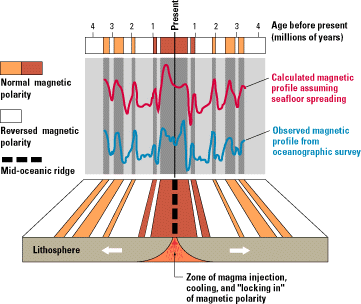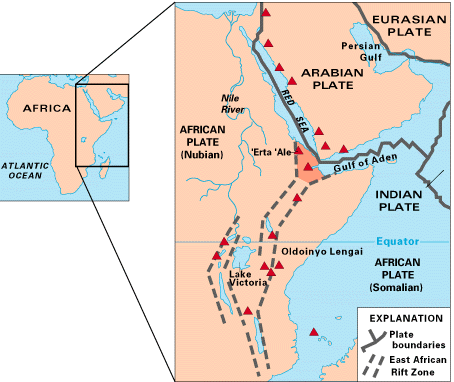|
Divergent Plate Boundary
In plate tectonics, a divergent boundary or divergent plate boundary (also known as a constructive boundary or an extensional boundary) is a linear feature that exists between two tectonic plates that are moving away from each other. Divergent boundaries within continents initially produce rifts, which eventually become rift valleys. Most active divergent plate boundaries occur between oceanic plates and exist as mid-oceanic ridges. Current research indicates that complex convection within the Earth's mantle allows material to rise to the base of the lithosphere beneath each divergent plate boundary. This supplies the area with huge amounts of heat and a reduction in pressure that melts rock from the asthenosphere (or upper mantle) beneath the rift area, forming large flood basalt or lava flows. Each eruption occurs in only a part of the plate boundary at any one time, but when it does occur, it fills in the opening gap as the two opposing plates move away from each other. O ... [...More Info...] [...Related Items...] OR: [Wikipedia] [Google] [Baidu] |
Triple Junction
A triple junction is the point where the boundaries of three tectonic plates meet. At the triple junction each of the three boundaries will be one of three types – a ridge (R), trench (T) or transform fault (F) – and triple junctions can be described according to the types of plate margin that meet at them (e.g. Fault-Fault-Trench, Ridge-Ridge-Ridge, or abbreviated F-F-T, R-R-R). Of the ten possible types of triple junction only a few are stable through time ('stable' in this context means that the geometrical configuration of the triple junction will not change through geologic time). The meeting of four or more plates is also theoretically possible but junctions will only exist instantaneously. History The first scientific paper detailing the triple junction concept was published in 1969 by Dan McKenzie and W. Jason Morgan. The term had traditionally been used for the intersection of three divergent boundaries or spreading ridges. These three divergent boundaries ideally ... [...More Info...] [...Related Items...] OR: [Wikipedia] [Google] [Baidu] |
Fred Vine
Frederick John Vine FRS (born 17 June 1939) is an English marine geologist and geophysicist. He made key contributions to the theory of plate tectonics, helping to show that the seafloor spreads from mid-ocean ridges with a symmetrical pattern of magnetic reversals in the basalt rocks on either side. Early life Vine was born in Chiswick, London, and educated at Latymer Upper School and St John's College, Cambridge where he studied Natural Sciences (BA, 1962) and marine geophysics (PhD, 1965). He married Susan 'Sue' Vine (née McCall), who worked as a research assistant for Drummond Matthews in the Department of Geodesy and Geophysics, University of Cambridge, contributing to the development of the sea-floor spreading hypothesis associated with Matthews and her husband. Plate Tectonics Vine's PhD thesis was on 'Magnetism in the Seafloor' and supervised by Drummond Matthews. Having met Harry Hess he was aware of sea floor spreading, where the ocean bed acts as a 'conveyor belt ... [...More Info...] [...Related Items...] OR: [Wikipedia] [Google] [Baidu] |
Lawrence Morley
Lawrence Whitaker Morley (February 19, 1920 – April 22, 2013) was a Canadian geophysicist and remote sensing pioneer. He was best known for his studies on the magnetic properties of the oceanic crust and their effect on plate tectonics and for starting the remote sensing program in Canada. Biography Morley worked on the theory of continental drift similar to work by Britons Fred Vine and Drummond Matthews. The three contributed significantly to geology by relating the magnetic properties of ocean crust to the processes involved in the theory of plate tectonics. Following graduate studies at the University of Toronto, Morley became Director of the Geophysics Branch of the Geological Survey of Canada in Ottawa (1950–1969). In 1970 he founded the Canada Centre for Remote Sensing and served as its Director General from 1971 to 1980. In 1974, Morley received an honorary degree from York University. He approached the university's faculty of science in 1985 to promote the creation ... [...More Info...] [...Related Items...] OR: [Wikipedia] [Google] [Baidu] |
Geomagnetic Reversal
A geomagnetic reversal is a change in a planet's magnetic field such that the positions of magnetic north and magnetic south are interchanged (not to be confused with geographic north and geographic south). The Earth's field has alternated between periods of ''normal'' polarity, in which the predominant direction of the field was the same as the present direction, and ''reverse'' polarity, in which it was the opposite. These periods are called '' chrons''. Reversal occurrences are statistically random. There have been at least 183 reversals over the last 83 million years (on average once every ~450,000 years). The latest, the Brunhes–Matuyama reversal, occurred 780,000 years ago, with widely varying estimates of how quickly it happened. Other sources estimate that the time that it takes for a reversal to complete is on average around 7,000 years for the four most recent reversals. Clement (2004) suggests that this duration is dependent on latitude, with shorter durations a ... [...More Info...] [...Related Items...] OR: [Wikipedia] [Google] [Baidu] |
Magnetic Reversal
A geomagnetic reversal is a change in a planet's magnetic field such that the positions of magnetic north and magnetic south are interchanged (not to be confused with geographic north and geographic south). The Earth's field has alternated between periods of ''normal'' polarity, in which the predominant direction of the field was the same as the present direction, and ''reverse'' polarity, in which it was the opposite. These periods are called '' chrons''. Reversal occurrences are statistically random. There have been at least 183 reversals over the last 83 million years (on average once every ~450,000 years). The latest, the Brunhes–Matuyama reversal, occurred 780,000 years ago, with widely varying estimates of how quickly it happened. Other sources estimate that the time that it takes for a reversal to complete is on average around 7,000 years for the four most recent reversals. Clement (2004) suggests that this duration is dependent on latitude, with shorter durations at ... [...More Info...] [...Related Items...] OR: [Wikipedia] [Google] [Baidu] |
Earth's Magnetic Field
Earth's magnetic field, also known as the geomagnetic field, is the magnetic field that extends from Earth's interior out into space, where it interacts with the solar wind, a stream of charged particles emanating from the Sun. The magnetic field is generated by electric currents due to the motion of convection currents of a mixture of molten iron and nickel in Earth's outer core: these convection currents are caused by heat escaping from the core, a natural process called a geodynamo. The magnitude of Earth's magnetic field at its surface ranges from . As an approximation, it is represented by a field of a magnetic dipole currently tilted at an angle of about 11° with respect to Earth's rotational axis, as if there were an enormous bar magnet placed at that angle through the center of Earth. The North geomagnetic pole actually represents the South pole of Earth's magnetic field, and conversely the South geomagnetic pole corresponds to the north pole of Earth's magnetic ... [...More Info...] [...Related Items...] OR: [Wikipedia] [Google] [Baidu] |
Subsidence
Subsidence is a general term for downward vertical movement of the Earth's surface, which can be caused by both natural processes and human activities. Subsidence involves little or no horizontal movement, which distinguishes it from slope movement. Processes that lead to subsidence include dissolution of underlying carbonate rock by groundwater; gradual compaction of sediments; withdrawal of fluid lava from beneath a solidified crust of rock; mining; pumping of subsurface fluids, such as groundwater or petroleum; or warping of the Earth's crust by tectonic forces. Subsidence resulting from tectonic deformation of the crust is known as tectonic subsidence and can create accommodation for sediments to accumulate and eventually lithify into sedimentary rock. Ground subsidence is of global concern to geologists, geotechnical engineers, surveyors, engineers, urban planners, landowners, and the public in general.National Research Council, 1991. ''Mitigating losses from land subsi ... [...More Info...] [...Related Items...] OR: [Wikipedia] [Google] [Baidu] |
Submarine Earthquake
A submarine, undersea, or underwater earthquake is an earthquake that occurs underwater at the bottom of a body of water, especially an ocean. They are the leading cause of tsunamis. The magnitude can be measured scientifically by the use of the moment magnitude scale and the intensity can be assigned using the Mercalli intensity scale. Understanding plate tectonics helps to explain the cause of submarine earthquakes. The Earth's surface or lithosphere comprises tectonic plates which average approximately 50 miles in thickness, and are continuously moving very slowly upon a bed of magma in the asthenosphere and inner mantle. The plates converge upon one another, and one subducts below the other, or, where there is only shear stress, move horizontally past each other (see transform plate boundary below). Little movements called fault creep are minor and not measurable. The plates meet with each other, and if rough spots cause the movement to stop at the edges, the motion of the ... [...More Info...] [...Related Items...] OR: [Wikipedia] [Google] [Baidu] |
Fracture Zone
A fracture zone is a linear feature on the ocean floor—often hundreds, even thousands of kilometers long—resulting from the action of offset mid-ocean ridge axis segments. They are a consequence of plate tectonics. Lithospheric plates on either side of an active transform fault move in opposite directions; here, strike-slip activity occurs. Fracture zones extend past the transform faults, away from the ridge axis; seismically inactive (because both plate segments are moving in the same direction), they display evidence of past transform fault activity, primarily in the different ages of the crust on opposite sides of the zone. In actual usage, many transform faults aligned with fracture zones are often loosely referred to as "fracture zones" although technically, they are not. Structure and formation Mid-ocean ridges are divergent plate boundaries. As the plates on either side of an offset mid-ocean ridge move, a transform fault forms at the offset between the two ridges ... [...More Info...] [...Related Items...] OR: [Wikipedia] [Google] [Baidu] |
East African Rift
The East African Rift (EAR) or East African Rift System (EARS) is an active continental rift zone in East Africa. The EAR began developing around the onset of the Miocene, 22–25 million years ago. In the past it was considered to be part of a larger Great Rift Valley that extended north to Asia Minor. A narrow zone, the rift is a developing divergent tectonic plate boundary where the African Plate is in the process of splitting into two tectonic plates, called the Somali Plate and the Nubian Plate, at a rate of 6-7 mm per year. The rift system consists of three microplates, the Victoria Microplate to the north, and the Rovuma and Lwandle microplates to the south. The Victoria Microplate is rotating anti-clockwise with respect to the African plate. Its rotation is caused by the configuration of mechanically weaker and stronger lithospheric regions in the EARS. Extent A series of distinct rift basins, the East African Rift System extends over thousands of kilometers. The ... [...More Info...] [...Related Items...] OR: [Wikipedia] [Google] [Baidu] |



